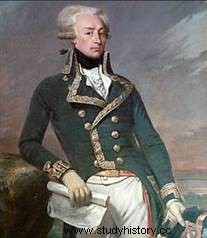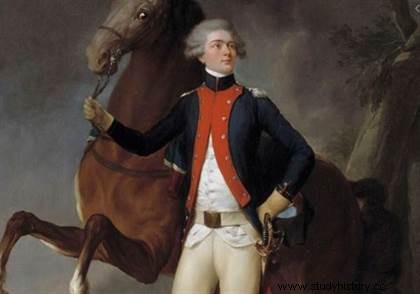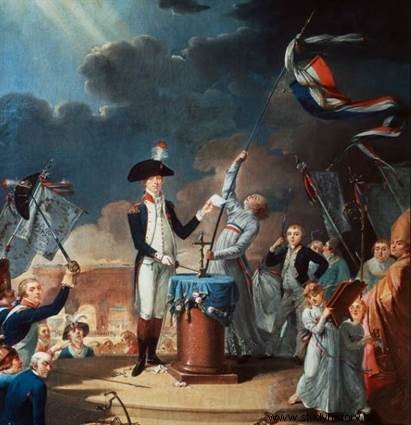 TheMarquis de La Fayette was a French general and politician, who distinguished himself during the American War of Independence and participated in the beginnings of the French Revolution. Aged only twenty, he embarked in 1777 on the Hermione to fight alongside the American colonists. Returning to France in 1779, he helped decide on French support for the insurgents. Deputy of the nobility of Riom to the States General, La Fayette was appointed commander of the National Guard on July 15, 1789. A supporter of the constitutional monarchy, he had to emigrate from 1792 to 1800. He was a liberal deputy under the Restoration and commanded the National Guard in July 1830, but soon broke away from the government of the July Monarchy.
TheMarquis de La Fayette was a French general and politician, who distinguished himself during the American War of Independence and participated in the beginnings of the French Revolution. Aged only twenty, he embarked in 1777 on the Hermione to fight alongside the American colonists. Returning to France in 1779, he helped decide on French support for the insurgents. Deputy of the nobility of Riom to the States General, La Fayette was appointed commander of the National Guard on July 15, 1789. A supporter of the constitutional monarchy, he had to emigrate from 1792 to 1800. He was a liberal deputy under the Restoration and commanded the National Guard in July 1830, but soon broke away from the government of the July Monarchy.
La Fayette, the American
Marie Joseph Gilbert Motier, Marquis de La Fayette, was born in Chavaniac in Haute-Loire on September 6, 1757. Orphaned young and having inherited a comfortable fortune, he was sent in Paris at Lycée Louis-le-Grand to study there. Embracing a military career, he joined the 2nd company of musketeers in 1771, then the regiment of Noailles, with the rank of second lieutenant. In 1774, La Fayette married Marie Adrienne Françoise de Noailles.
 Enthused by the cause of the rebellious American colonists, he traveled to America in April 1777, despite the king's orders . Arrived in Georgetown on June 15, he put himself in the service of the insurgents. La Fayette took part in the Battle of Brandywine, during which he was wounded and then given command of the troops of Virginia. He took part in several successful military engagements (notably at Monmouth as division commander), before returning to France to plead the American cause with Louis XVI. When London declares war on Paris, it obtains new financial and military aid.
Enthused by the cause of the rebellious American colonists, he traveled to America in April 1777, despite the king's orders . Arrived in Georgetown on June 15, he put himself in the service of the insurgents. La Fayette took part in the Battle of Brandywine, during which he was wounded and then given command of the troops of Virginia. He took part in several successful military engagements (notably at Monmouth as division commander), before returning to France to plead the American cause with Louis XVI. When London declares war on Paris, it obtains new financial and military aid.
La Fayette obtains that a body of about 6000 men, commanded by General Rochambeau, be sent across the Atlantic. He leads with this famous general a campaign which forces Cornwallis, surrounded in Yorktown, to capitulate on October 17, 1781. This victory was to lead to the independence of the United States. Then begins a period of travel between France and the American continent, where he is now welcomed as a hero. In February 1787, the advanced ideas he expressed earned him some coldness from the royal entourage. He was elected in March 1789 deputy of the nobility of the seneschalsy of Riom to the States General.
In the tumult of the French Revolution
In 1790, La Fayette enjoyed exceptional popularity. The "hero of two worlds" represents the former party of patriots in the Constituent Assembly. Although a convinced revolutionary, he has also been the protector of the royal family since October 1789. This choice and his fame place him at the center of the constitutional debate. Ambitious, this illustrious Freemason, after having created the Society of Friends of Blacks with Brissot, presented on July 11 a draft European Declaration of Human Rights and the Dean. He was named the 13th Vice-President of the Assembly, and, on the 15th, Commander-in-Chief of the National Guard of Paris. He saves the threatened royal family at Versailles during the days of riots on October 5 and 6, 1789.
 La Fayette was at the height of his popularity when he hosted the Fête de la Fédération on July 14, 1790. C It was he again who brought back the king prisoner after the flight from Varennes, while pleading for the maintenance of Louis XVI on the throne. Lieutenant general at the end of June 1791, he severely suppressed the demonstration on the Champ-de-Mars (July 17, 1791), firing on the people. Discredited in the eyes of the revolutionaries, he had to resign (October 8, 1791). In 1792, he led an army against Austria, hoping that a victory would allow him, in agreement with the Girondins, to seek power. However, his opposition to the Jacobins grew; they accuse him of turning his troops against Paris to seize power. Put at the head of the armies in charge of repelling the foreign invasion, he achieved some successes in the Sambre.
La Fayette was at the height of his popularity when he hosted the Fête de la Fédération on July 14, 1790. C It was he again who brought back the king prisoner after the flight from Varennes, while pleading for the maintenance of Louis XVI on the throne. Lieutenant general at the end of June 1791, he severely suppressed the demonstration on the Champ-de-Mars (July 17, 1791), firing on the people. Discredited in the eyes of the revolutionaries, he had to resign (October 8, 1791). In 1792, he led an army against Austria, hoping that a victory would allow him, in agreement with the Girondins, to seek power. However, his opposition to the Jacobins grew; they accuse him of turning his troops against Paris to seize power. Put at the head of the armies in charge of repelling the foreign invasion, he achieved some successes in the Sambre.
As the democratic and popular movement takes the Revolution in hand, La Fayette is declared a traitor to his country. After having taken up, with great courage, the defense of the throne, the day after the days of June and August 1792, he crossed the border after having tried in vain to raise his army in favor of Louis XVI. He fell into the hands of the Austrians who, considering him one of the instigators of the Revolution, imprisoned him in the fortress of Olmütz in Moravia. La Fayette will stay five years in his jail. It is only by the treaty of Campo-formio (1797) that he will recover his freedom. Three later, he retired to his estate in Seine-et-Marne, from where he witnessed the imperial epic.
The end of La Fayette's career
After having supported Louis XVIII, during the First Restoration, he espoused, when the return from Elba was announced, the cause of the Emperor. Member of Parliament for Seine-et-Marne on May 10, 1815, he was vice-president of the Assembly. However, he was one of those who contributed to the downfall of the vanquished at Waterloo on June 22, 1815. This versatile attitude did not prevent him from obtaining from the provisional government the post of commissioner near the headquarters of the allies. La Fayette found himself deputy for Sarthe in 1818. A member of Charbonnerie, he was defeated in the 1824 elections and returned to the United States at the invitation of Congress. he stays there for two years, receiving a gift of 200,000 dollars and vast land holdings. This trip is a personal triumph.
Back in France in 1825, La Fayette was once again elected deputy for Seine-et-Marne in 1827 and then, after the Trois Glorieuses revolution, was given command of the National Guard but resigned shortly after, following a dispute between him and King Louis-Philippe. La Fayette died in Paris on May 20, 1834, leaving in France a mixed memory because of his political ambivalences and his Caesarist temptations. However, throughout his career he advocated social equality, popular representation, religious tolerance and freedom of the press. In 1917, grateful Americans enlisted alongside France in the First World War to the cry of “La Fayette, we are here!” ". In 2002, the Marquis will posthumously receive American citizenship.
Bibliography
- La Fayette, biography of Jean-Pierre Bois. Perrin, 2015.
- Lafayette, herald of freedom, by Laurent Zecchini. Fayard, 2019.
